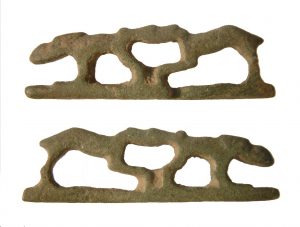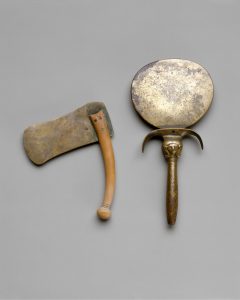You might have guessed that razors have been around for a while, possibly from reading our other articles. But they’ve been around for a really long time.
Stone Age
Since the Stone Age we have reliable evidence that people have been shaving, so roughly the last 100,000 years, give or take a millennia or 2. During this period the planet was going through some pretty bad temperature drops, which we colloquially know as ‘Ice Ages’, a bit chilly then. Facial hair in that time was actually a bit problematic: wet hair from rain and snow would freeze against the skin, causing some pretty bad frostbite in an age without any medicine, which would most likely prove fatal.
So how do you prevent this? Get rid of it. And they had some gnarly ways of doing it: early on they just pulled the hair out with seashells used as tweezers (can you imagine how much that would sting?). After realising that this was pretty painful they took the next step and started using flakes of obsidian and shell shards to shave ‘properly’, and this worked for a good 90,000 years or so. You would think a decent brush and bowl would have been appreciated! Amazingly, the earliest depilatory creams, something we thought would have only been around the past few decades, were made around 3000 BC, from arsenic, quicklime and starch.
Ancient Egypt
Egyptians were the next lot to improve on this method, and they had pretty good reasons. They shaved to appear and be clean, bathing several times daily and shaving their entire bodies. Egypt is pretty hot, especially around the Nile delta, so long hair would have been intolerable. And living in these newfangled ‘communities’ and ‘towns’ pests like head-lice were a bit of a nuisance, so going bare hair made even more sense!
Egyptians managed this necessary look through using circular and hatchet-shaped ‘rotary’ bladed razors and depilatory creams. On top of this they used pumice stones to remove all traces of stubble. The Dark Stag Shaving Brush lifts hairs so you can ensure to get the closest shave possible!
Greeks and Romans

An iron novacila, supposedly showing a hound chasing a hare… that’s either a tiny dog or a giant hare
The Greeks and Romans started to realise the potential of the razor, straightening out the circular razor into a form similar to today. Quality also improved, making their razors out of copper and iron instead of the easily dulled bronze. The novacila, the roman razor, was a block of iron with some finger holes or handle, and a blade. Simple but effective.
The Romans copied the Egyptians and Greeks by also using pumice stones to get rid of stubble. Nicks from dull razors were treated with a delightful plaster ointment, made from spider webs soaked in oil and vinegar. Keeping your blades sharp with a strop will stop any nicks during having.
The reason for the popularity of beards not only lie with the Egyptians, Alexander the Great ordered his troops to shave after a catastrophic defeat at the hands of the Persians, where beards were grabbed, held, and the wearer speared. This trend carried on after the wars, largely due to Alexander’s popularity, almost like a modern celebrity endorsement.
Stagnation
The dark and middle ages saw little in the way of changed and innovation, which is surprising seeing as it was the age of enlightenment. You can see the rise and fall of facial hair popularity simply by looking at portraits of monarchs, who the lower folk would copy in an attempt to flatter and appease. Fortunately, the Dark Stag Shaving Set will always keep you in facial fashion fads.But other than that, nothing really changed. So we’ll skip over about 1,700-ish years of history… yikes.
The 18th Century
Up until the 18th century razors were only seen as sharp, exposed slabs of metal. Early on in this period they started to get a bit more attention, becoming the delicate, beautifully crafted designs we know and love today, something to be proud of. Something like the Dark Stag Premium Straight Razor. Men still went to the barbers to be shaved by these specialised tools!
Modern Safety Blades
French inventor Jean-Jacques Perret developed the world’s first safety razor by slapping a wooden guard onto a standard straight razor. This design was improved in the early 19th century into the modern Sheffield straight razor. Then, in 1880, the Kampfe brothers invented a wire guard along the edge of the blade as well as lather-catching head.
The problem with the Kampfe brothers’ safety razor was the fact the head had to be routinely removed from the handle and sharpened on a whet stone. But rather than go through the trouble of sharpening that head, why not just replace it with a new one? King C. Gillette concocted the idea, and after 8 years, and the help of an MIT professor, he had created the first double-edge safety razor.
By 1906 Gillette was selling over 300,000 a year. The next decade saw a massive change, he was a household name and now selling his ‘Milady Decolletée’ specifically to women.
Dark Stag has carried on with this idea and made it’s own replaceable blade razor!
The Advent of Electricity
The final (for now) chapter in shaving is: the age of electricity. Jacob Schick patented his own design in 1928, which flopped dramatically (blame the stock market crash and unwieldy design). His second design however, consolidated the clumsy motor and hose setup into one sleek device, which sold very well, at $25 ($350 today) and selling 3,000 units in the first year. The base design has been continuously improved on until you get to modern electric devices today!
There you have it, the history of the razor, from seashells to your Philips, or your Dark Stag if you will.
Until next time
Dark Stag Team
All images displayed in this article are used from wikimedia commons.









